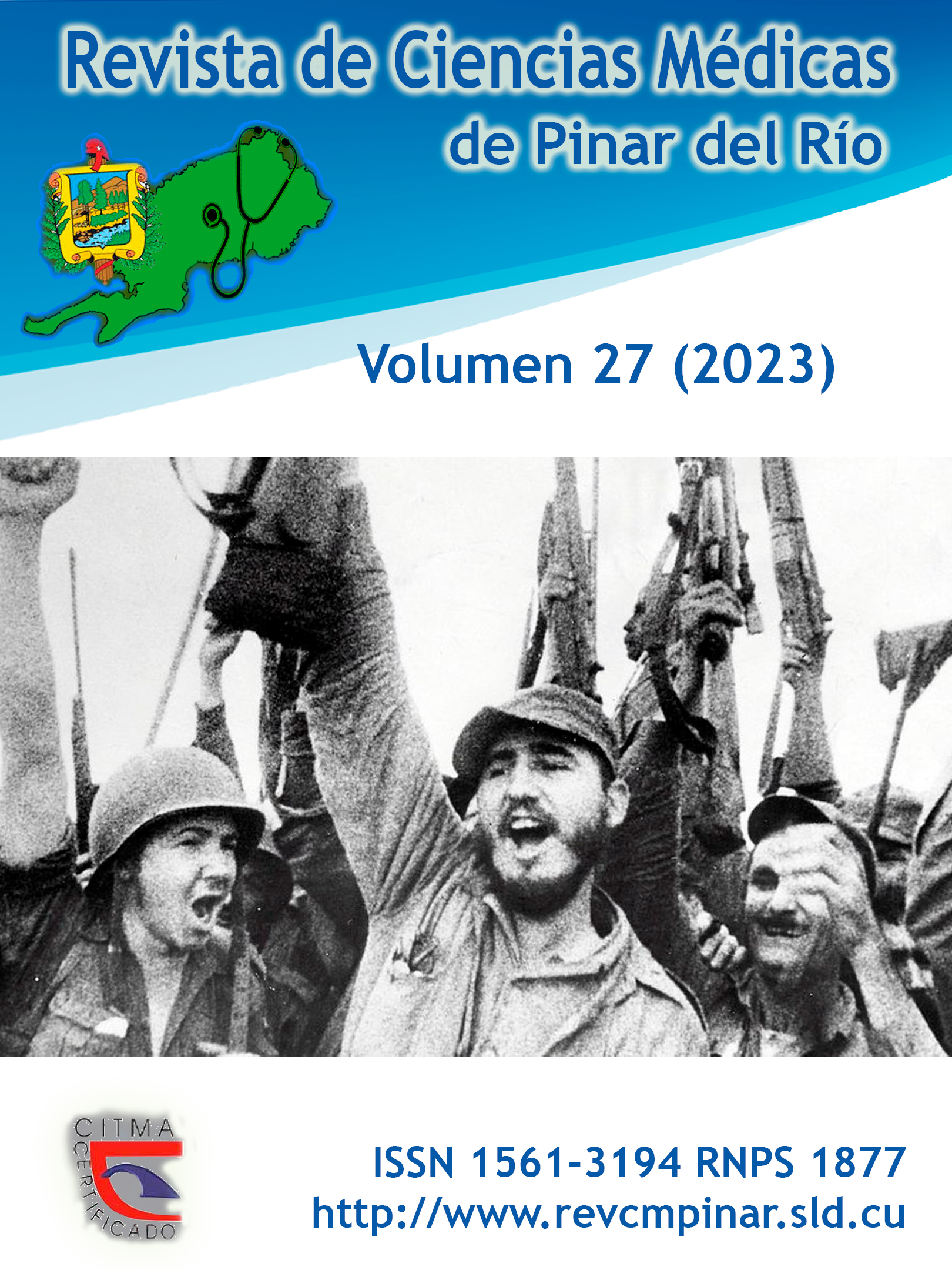Integration of biomedical sciences into student research and education. Benguela. Angola, 2020
Keywords:
BIOMEDICAL SCIENCES, TEACHING ACTIONS, RESEARCH, EDUCATION.Abstract
Introduction: the teaching process of biomedical sciences demands changes with innovative qualities where the teacher's role is to create strategies that achieve the integration of basic research with practice, allowing students to establish new points of reference for research and education.
Objective: to expose teaching actions to integrate the subjects Embryology II and Anatomy II to the development of research and educational work of the medical student of the University Katyavala Bwila of Benguela in Angola.
Methods: descriptive, observational study using theoretical methods at the Faculty of Medicine of the University Katyavala Bwila in Benguela Angola in the school year 2020-2021. Teaching actions were designed to strengthen the development of research and the student's educational work in the subjects Embryology II and Anatomy II.
Results: the actions allowed centralizing the teaching process in the search for information, stimulated research skills, linked learning with environmental problems and encouraged the acquisition of moral and civic values in students according to the professional model according to the social task.
Conclusions: the search for information allowed the gain of competences and skills in the scientific creation of the medical student and the acquisition of values proper to the profession, facilitating the integration of basic biomedical sciences to the development of research and education of the student.
Downloads
References
1. Otero Rodríguez I, Liy Isada MV, Velázquez García L. El trabajo independiente en las ciencias básicas biomédicas en la Facultad de Medicina de Benguela. Rev Ciencias Médicas [Internet]. 2019 Abr [citado 20/07/2022]; 23(2): 341-50. Disponible en: http://scielo.sld.cu/scielo.php?script=sci_arttext&pid=S1561-31942019000200341&lng=es
2. Muguercia Fornaris A, Rizo Vázquez X. Guía metodológica para la ejecución de un seminario panel en los contenidos embriológicos. Artemisa: I Jornada Científica de Farmacología y Salud [Internet]. Fármaco Salud Artemisa; 2021. [citado 20/07/2022]: [aprox. 16 p.]. Disponible en: https://farmasalud2021.sld.cu/index.php/farmasalud/2021/paper/viewFile/134/51
3. Chaple Gil AM, Corrales Reyes IE, Quintana Muñoz L, Fernández E. Indicadores bibliométricos sobre evaluación de programas de estudio de ciencias médicas en revistas biomédicas cubanas. Revhabanciencméd. [Internet]. 2020 Feb [citado 20/07/2022]; 19(1): 154-66. Disponible en: http://scielo.sld.cu/scielo.php?script=sci_arttext&pid=S1729-519X2020000100154&lng=es
4. Sentí M, Presas A, Baños JE. La enseñanza de la relación mutua entre ciencias biomédicas y sociedad. La experiencia de biomedicina, sociedad y cultura. Edumed [Internet]. 2019 [citado 20/07/2022]; 20(6): 347-52. Disponible en:https://www.sciencedirect.com/science/article/pii/S1575181318301724
5. Lavandero Espina A, Rodríguez Oropesa K, Delfín Soto O, Gutiérrez M, Buenaventura A. La asignatura Regulación Hormonal del Metabolismo y Reproducción: una necesidad en la carrera de Estomatología. EDUMECENTRO [Internet]. 2019 Jun [citado 20/07/2022]; 11(2): 19-31. Disponible en: http://scielo.sld.cu/scielo.php?script=sci_arttext&pid=S2077-28742019000200019&lng=es
6. Núñez EE, Blanco BN, Jiménez JE. Tareas docentes para el desarrollo de habilidades investigativas desde la educación en el trabajo. EduMeCentro [Internet]. 2020 [citado 20/07/2022]; 12(2): 146-60. Disponible en: https://www.medigraphic.com/pdfs/edumecentro/ed-2020/ed202k.pdf
7. Ortiz Aguilar W, Santos Díaz L, Rodríguez Revelo E. Estrategias didácticas en entornos virtuales de enseñanza-aprendizaje universitarios. Opuntia Brava [Internet]. 2020 [citado 20/07/2022]; 12(4): 68-3. Disponible en: https://opuntiabrava.ult.edu.cu/index.php/opuntiabrava/article/view/1105
8. Revelo Sánchez CA, Collazos Ordoñez J, Jiménez Toledo A. El trabajo colaborativo como estrategia didáctica para la enseñanza/aprendizaje de la programación: una revisión sistemática de literatura. Tecnológicas [Internet]. 2018 jun [citado 20/07/2022]; 21(41): 115-34. Disponible en: http://www.scielo.org.co/pdf/teclo/v21n41/v21n41a08.pdf
9. Rodríguez Zamora R, Espinoza Núñez LA. Trabajo colaborativo y estrategias de aprendizaje en entornos virtuales en jóvenes universitarios. RIDE. Rev. Iberoam. Investig. Desarro. Educ [Internet]. 2017 Jun [citado 20/07/2022]; 7(14): 86-109. Disponible en: http://www.scielo.org.mx/scielo.php?script=sci_arttext&pid=S2007-74672017000100086&lng=es
10. Sánchez González MÁ. El humanismo y la enseñanza de las humanidades médicas. Edumed [Internet]. 2017 [citado 20/07/2022]; 18(3): 212-8. Disponible en: https://www.sciencedirect.com/science/article/pii/S1575181317300463?via%3Dihub
11. Leiva Suero LE, Hernández Navarro EV. Novedades metodológicas para la enseñanza de las Ciencias Biomédicas. Enfermería Investiga [Internet]. 2019 [citado 20/07/2022]; 4(1): 1. Disponible en: https://revistas.uta.edu.ec/erevista/index.php/enfi/article/view/486
12. Segredo Pérez AM, Reyes Miranda D, Quintana Galende ML, Díaz Lemus M, García Hernández I, Díaz Hernández L. Desarrollo de habilidades investigativas en el campo de la Salud Pública. Educ Med Super [Internet]. 2017 Mar [citado 20/07/2022]; 31(1): [aprox. 22 p.]. Disponible en: http://scielo.sld.cu/scielo.php?script=sci_arttext&pid=S0864-21412017000100005&lng=es
13. Piloto Porras DC, González Miló A, González González M, Ortiz Castillo LE, González Rodríguez R. Interdisciplinariedad desde la disciplina Medicina General Integral hacia las Ciencias Básicas Biomédicas. Revista Universidad Médica Pinareña [Internet]. 2018 [citado 20/07/2022]; 14(3): 257-66. Disponible en: http://galeno.pri.sld.cu/index.php/galeno/article/view/526
14. Ríos González CM. Obstáculos para la investigación científica en estudiantes de Medicina del Paraguay. Edumed [Internet]. 2017 [citado 20/07/2022]; 18(1): 78-9. Disponible en: https://doi.org/10.1016/j.edumed.2016.07.009
Downloads
Published
How to Cite
Issue
Section
License
Authors who have publications with this journal agree to the following terms: Authors will retain their copyrights and grant the journal the right of first publication of their work, which will be publication of their work, which will be simultaneously subject to the Creative Commons Attribution License (CC-BY-NC 4.0) that allows third parties to share the work as long as its author and first publication in this journal are indicated.
Authors may adopt other non-exclusive license agreements for distribution of the published version of the work (e.g.: deposit it in an institutional telematic archive or publish it in a volume). Likewise, and according to the recommendations of the Medical Sciences Editorial (ECIMED), authors must declare in each article their contribution according to the CRediT taxonomy (contributor roles). This taxonomy includes 14 roles, which can be used to represent the tasks typically performed by contributors in scientific academic production. It should be consulted in monograph) whenever initial publication in this journal is indicated. Authors are allowed and encouraged to disseminate their work through the Internet (e.g., in institutional telematic archives or on their web page) before and during the submission process, which may produce interesting exchanges and increase citations of the published work. (See The effect of open access). https://casrai.org/credit/



